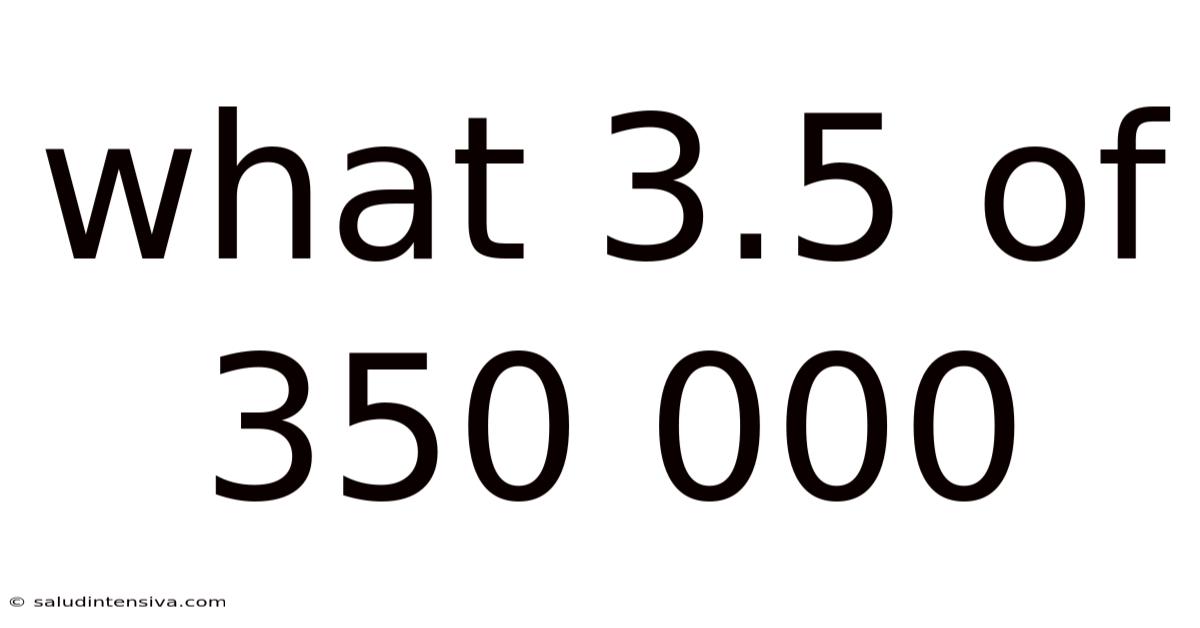What 3.5 Of 350 000
saludintensiva
Sep 20, 2025 · 4 min read

Table of Contents
What is 3.5% of 350,000? A Comprehensive Guide to Percentage Calculations
Understanding percentages is a fundamental skill applicable across various aspects of life, from calculating discounts and taxes to comprehending statistical data and financial reports. This article will delve into the calculation of "What is 3.5% of 350,000?", providing a step-by-step explanation, exploring different calculation methods, and highlighting practical applications. We will also address common misconceptions and frequently asked questions surrounding percentage calculations. By the end, you'll not only know the answer but also possess a solid understanding of how to tackle similar percentage problems independently.
Understanding Percentages
A percentage is a fraction or ratio expressed as a number out of 100. The symbol "%" represents "per cent," meaning "out of one hundred." Therefore, 3.5% can be understood as 3.5 out of 100, or 3.5/100.
Calculating 3.5% of 350,000: Method 1 – Converting to Decimal
The most straightforward method involves converting the percentage to its decimal equivalent and then multiplying it by the given number.
Step 1: Convert the Percentage to a Decimal
To convert 3.5% to a decimal, divide the percentage by 100:
3.5% ÷ 100 = 0.035
Step 2: Multiply the Decimal by the Number
Now, multiply the decimal equivalent (0.035) by the given number (350,000):
0.035 × 350,000 = 12,250
Therefore, 3.5% of 350,000 is 12,250.
Calculating 3.5% of 350,000: Method 2 – Using Fractions
Alternatively, you can solve this using fractions.
Step 1: Express the Percentage as a Fraction
3.5% can be written as the fraction 3.5/100. To simplify, we can multiply both numerator and denominator by 10 to remove the decimal:
(3.5 × 10) / (100 × 10) = 35/1000
Further simplification by dividing both by 5 gives us 7/200.
Step 2: Multiply the Fraction by the Number
Now, multiply this fraction by 350,000:
(7/200) × 350,000 = (7 × 350,000) / 200 = 2,450,000 / 200 = 12,250
Again, we find that 3.5% of 350,000 is 12,250.
Understanding the Result in Context
The result, 12,250, represents a portion of the total value 350,000. Imagine you have 350,000 items, and you want to separate out 3.5% of them. The calculation shows that you would have 12,250 items in that 3.5% subset. This can be applied to various scenarios:
- Financial Calculations: Calculating interest, taxes, commissions, or discounts. For instance, a 3.5% commission on sales of 350,000 would amount to 12,250.
- Statistical Analysis: Determining a percentage of a population, a sample size, or a particular characteristic within a dataset.
- Real-World Problems: Calculating the percentage of students achieving a certain grade, the percentage of defective products in a batch, or the percentage of land used for a specific purpose.
Practical Applications and Examples
Let's consider some real-world examples to solidify our understanding:
Example 1: Sales Commission
A salesperson earns a 3.5% commission on total sales. If their total sales for the month are 350,000, their commission would be 12,250 (3.5% of 350,000).
Example 2: Tax Calculation
Suppose a certain good is subject to a 3.5% sales tax. If the pre-tax price is 350,000, the sales tax would be 12,250. The final price, including tax, would be 362,250.
Example 3: Population Statistics
If a city has a population of 350,000 and 3.5% of the population is unemployed, then the number of unemployed people is 12,250.
Addressing Common Misconceptions
One common mistake is confusing percentage with absolute value. 3.5% of 350,000 is not simply adding 3.5 to 350,000. Percentage calculations involve finding a fraction of a given value, not a simple addition or subtraction.
Another misconception is the inaccurate conversion of percentages to decimals. Remember always to divide the percentage by 100 before multiplying.
Frequently Asked Questions (FAQ)
Q: How do I calculate a different percentage of 350,000?
A: Follow the same steps outlined above, simply replacing 3.5% with the desired percentage. Convert the new percentage to a decimal and multiply it by 350,000.
Q: What if I need to calculate x% of y?
A: The general formula is: (x/100) * y. Replace 'x' with the percentage and 'y' with the number.
Q: Are there any online calculators available for percentage calculations?
A: Yes, many online calculators can perform percentage calculations quickly and easily. However, understanding the underlying principles is crucial for applying this skill across various contexts.
Q: Why is understanding percentage calculations important?
A: Percentage calculations are essential in numerous fields, including finance, statistics, business, science, and everyday life. Mastering these calculations improves problem-solving skills and enhances comprehension of numerical data.
Conclusion
Calculating 3.5% of 350,000 is a straightforward process once you understand the fundamental principles of percentage calculations. Whether you use the decimal method or the fraction method, the answer remains consistent: 12,250. This article has not only provided the solution but also equipped you with the knowledge and tools to tackle similar percentage problems confidently and accurately. Remember that a strong grasp of percentages is a valuable asset in various aspects of life, both personal and professional. By understanding the concepts and applying the methods outlined, you can confidently navigate the world of percentages and leverage this knowledge to solve real-world problems. Practice regularly, and you'll find that percentage calculations become second nature.
Latest Posts
Latest Posts
-
30 Days From June 6
Sep 21, 2025
-
1000 Cubic Inches To Liters
Sep 21, 2025
-
180 Degrees Celsius To Fahrenheit
Sep 21, 2025
-
1 3 Of 1 Million
Sep 21, 2025
-
Mach To Kilometers Per Hour
Sep 21, 2025
Related Post
Thank you for visiting our website which covers about What 3.5 Of 350 000 . We hope the information provided has been useful to you. Feel free to contact us if you have any questions or need further assistance. See you next time and don't miss to bookmark.